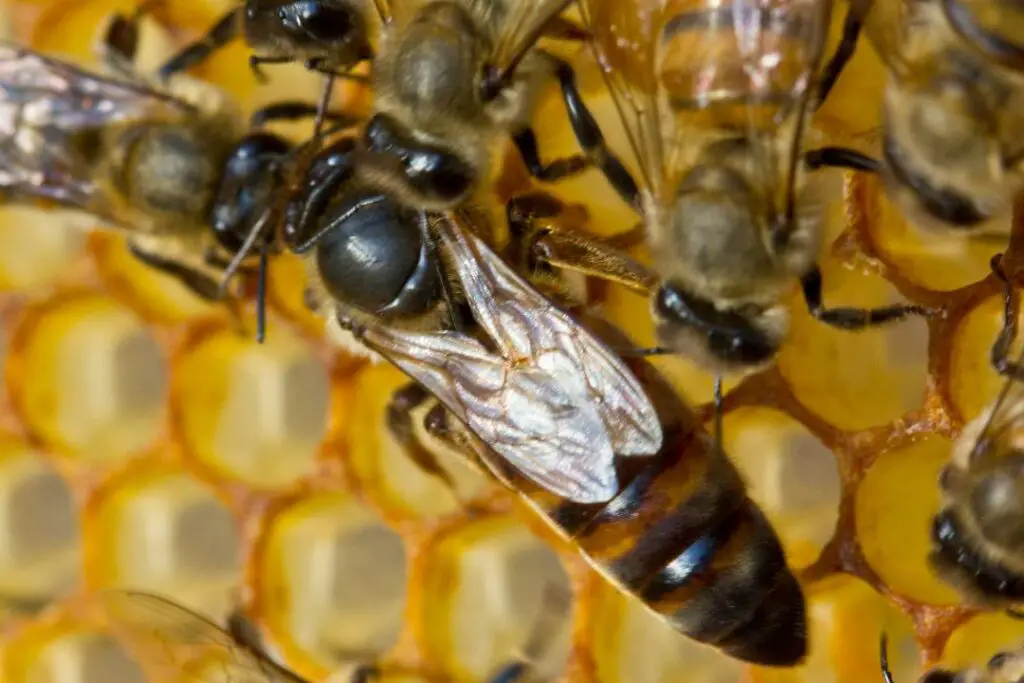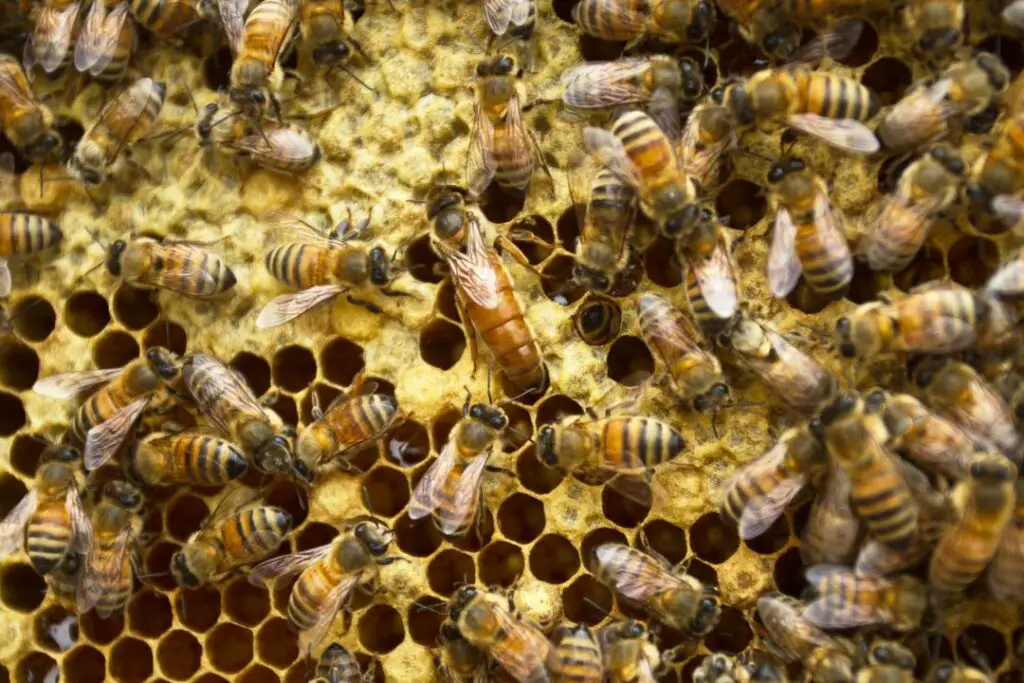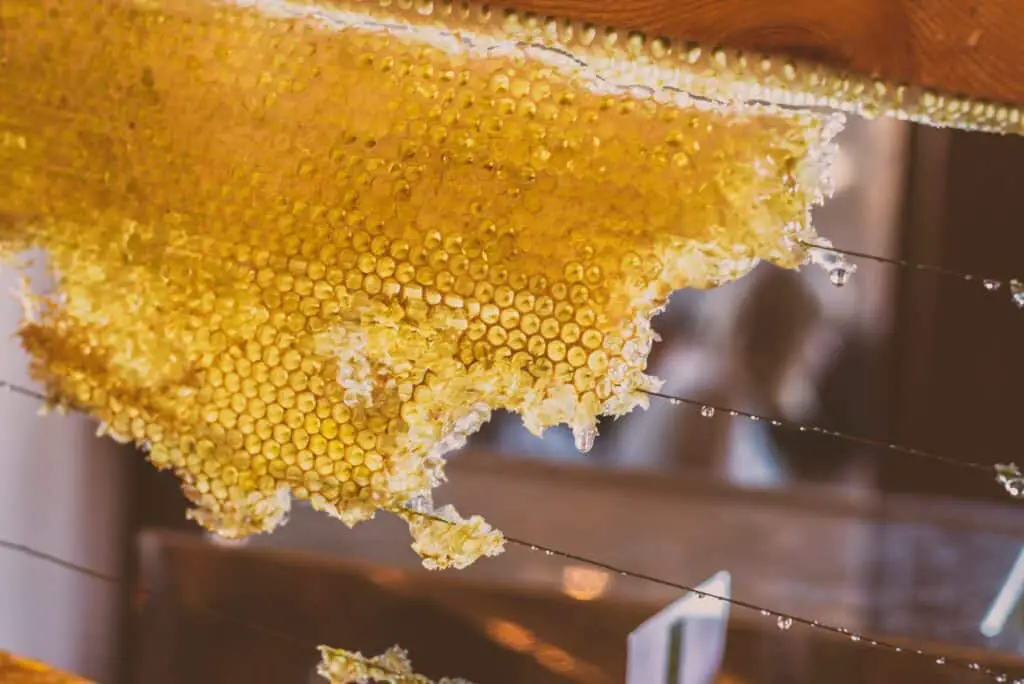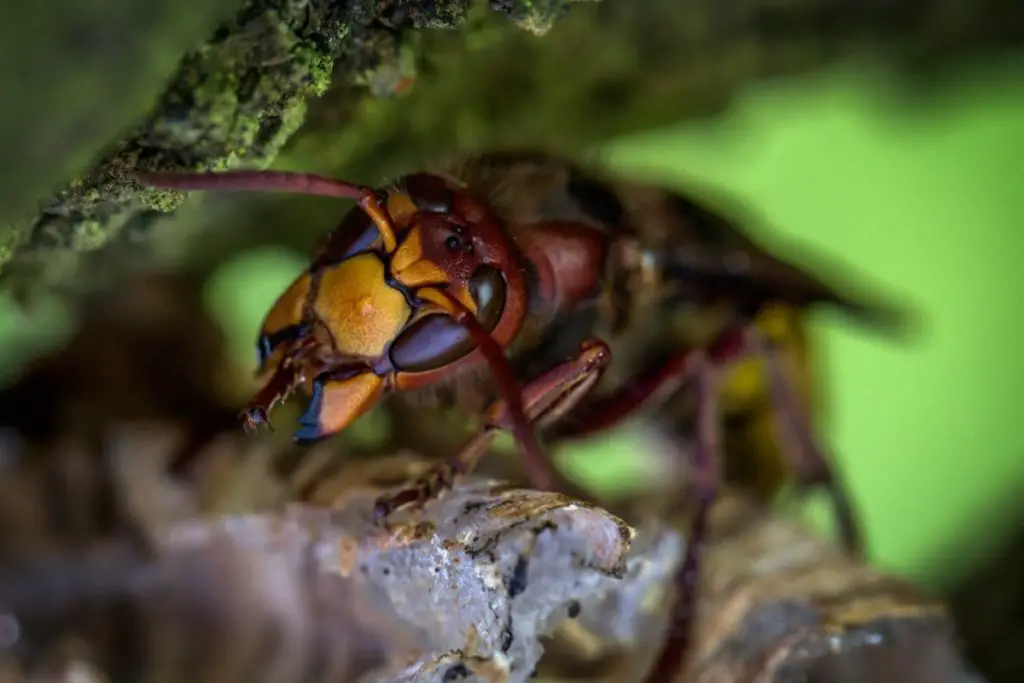Last updated on January 5th, 2024 at 10:35 am
If a queen bee is killed, the worker bees try to raise a new queen by feeding select larvae royal jelly. The first emerging queen eliminates rivals and mates with drones to continue the colony.
If a new queen cannot be raised, the colony will decline in population and die out.
So as you can see, the repercussion of a queen dying is huge for her nest or hive.
With the whole colony’s existence hanging in the balance, let’s look closely at what happens when a queen bee dies.
The Queen’s Role In The Colony

Honeybee queens release a pheromone while in the hive, communicating their presence and reign to their subjects.
When leaving to mate, a honeybee queen will release this pheromone in more significant amounts to ensure her workers are aware of her continued monarchy and do not start the process of replacing her.
A honeybee queen’s typical mating flight lasts a maximum of 45 minutes.
The colony’s inhabitants are acutely aware of this, and after 50 minutes without their queen returning, they will begin to suspect something is wrong.
The lack of a queen pheromone will tell the worker bees they need to act to ensure the hive or nests’ survival.
Every hive needs a queen to lay and fertilize eggs, and the queen’s pheromones ensure the continued reign over the other bees in the hive.
But what happens when a queen bee dies, is lost to a predator, or expires unexpectedly?
What Happens When The Queen Bee Dies?
If a colony loses its queen due to predators or unexpected circumstances, the worker bees will become briefly agitated and then set about rearing a new emergency queen.
Female larvae under three days old will be moved to ‘queen cells’ and fed a strict diet of ‘royal jelly’ until they mature into a new queen.
Did you know that bees can turn on their queen in an act of treason? Find out why bees rise up and kill their queen here.
Reasons For Unexpected Queen Loss
First of all, it is very important to differentiate between raising a queen in an emergency when a queen bee dies and the process of supersedure.
Supersedure is the natural process in which an ageing queen is replaced by a younger matriarch when her ability to lay eggs and produce pheromones decreases.
An emergency queen is reared when the queen is lost unexpectedly and suddenly, leaving the worker bees very little time to find and rear a replacement.
So what are some of the reasons for the unexpected death of a queen and the consequent rush to replace her?
Predators

Believe it or not, in the UK, badgers are probably the largest threat to the queen specifically. Badgers use strong, sharp claws to dig their way inside nests and hives to access the calorie-rich honey and larvae inside.
During this process, the badger can kill the queen, inadvertently leaving the hive to produce another. While other predators pose a serious threat to the queen, the badger is a risk even at the centre of her domain.
Interestingly bees have evolved to display black and yellow stripes as a warning to predators they are carrying a painful sting and consuming them will be an unpleasant ordeal.
Wasps and flies are known to use nests as a location to lay their young, and in some rather unpleasant cases, the bees themselves are used to house the developing offspring of invaders.
During swarming, the list of predators increases vastly. The worker bees will try their best to keep the queen safely at the swarm’s centre.
However, in this vulnerable state, birds become a risk as the hive navigates its way to a new home.
Disease
When a queen bee dies due to a predator attack, it really is instant and leaves the leaderless colony to act with little to no warning. In cases where a queen falls ill from a disease or parasite, the effects will become apparent over time.
A reduction in ‘queen substance’ production signals to the other worker bees not to produce young and a pronounced slowing in egg production and fertilization.
In these cases, the worker bees within the hive will be granted slightly more time to produce a new monarch.
- 🐝🐝🐝 Wildlife Gifts To Help Bees & Pollinators - Your Bee Revival Keyring contains a special...
- 🎁🎁🎁 Bee Gifts For Women - Give the gift of giving with our bee accessories from Revive a...
- 🌱🌱🌱 Plantable Seed Paper Packaging/Seed Gifts - What makes the perfect eco gift? We think...
- 🌍🌎🌏 Planet Friendly Gadget Keyring - A great gift for a friend or loved one who cares about...
- 🐾🐾🐾 Supports Rewilding Britain - A percentage of every sale will be donated to Rewilding...
Worker Bees Immediate reaction
When a queen bee dies, the first thing a worker bee will pick up on is a drop-in ‘queen substance’, the pheromone produced by the queen.
This will lead to agitation throughout the hive but will be very quickly replaced with a single goal.
Replacing the queen is time-sensitive and could have dire consequences for the other bees in her charge.
The worker bees will find suitable larvae to be raised into queens. Strict criteria must be met before female larvae are even considered potential heirs to the throne.
The larvae must be female and can not be any older than three days. These larvae will be placed in vertical queen cells within the honeycomb structure.
Raising A New Queen
Rather than just selecting one larva, when the queen bee dies, the worker bees within a nest or hive will select many, increasing their chances of a successful replacement.
All of these potential new queens are fed an exclusive diet of royal jelly, a much more concentrated version of the jelly fed to drone and worker larvae.
This process will continue for approximately six days of growth when they are sealed into the cell to become pupae. Eight days following, a brand new queen will emerge from the cell to take her throne.
Taking The Throne

When a new queen emerges, her first task is to ensure her rule, eliminating potential competitors. The virgin queen will move around the hive, killing potential rivals, ideally before they emerge from the cell at full maturity.
Once this process is complete, the queen’s next goal is to ensure the hive’s continued survival.
She must first take a few flights from the hive to familiarise herself with the landscape.
After a few flights, she will fly around 20ft into the air to mate with drone bees from other hives.
A queen bee will mate with up to 20 drones, collecting sperm in her spermatheca for fertilizing eggs.
This process ensures the queen has ample sperm to fertilize the eggs she will lay at the hive.
Unfortunately, the drone bees will not survive this courtship, but their role has been completed.
The entire timeline from the loss of the queen to the new queen beginning to lay eggs is only 29 days to reduce the impact on the hive and the bees within.
During this 29-day period, no new worker bees will be raised due to the lack of a queen for fertilization.
When A Queen Dies With No Replacement
Unfortunately, replacing a queen in an emergency is not always successful. This has severe consequences for the hive and the bees within.
When a queen bee dies, the worker bees become agitated and more aggressive without their monarch’s direction.
Because of the lack of a queen substance pheromone, worker bees will begin to lay eggs.
Workers cannot fertilize eggs, so the hive produces too many male drones.
As drones have no use outside of mating, they are a huge drain on resources and lead to the eventual decline and disappearance of the colony.
This may be caused by disease or parasites, but in some cases, the colony dies out purely because it produces no worker bees to continue the operation of the hive.
So when a queen bee dies, the urgency for raising a new one can leave the colony at serious risk.

What Happens If You Kill A Queen Bee?
You can expect a fierce response from her subjects in the form of swarming and stinging.
You should never actively try to kill a queen bee. If you’re being bothered by bees in your home or garden, always seek out professional advice for both your safety and the safety of the bees,
For more fascinating insect facts, check out another short read on what happens when a queen wasp dies.





